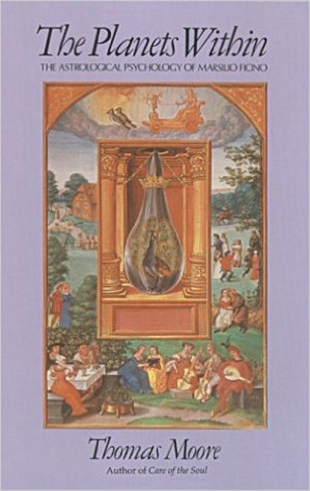"While constellation refers to an inner patterning, the provision of various kinds of spirit for the vitality of psychological life, it implies a corresponding 'cultivation' of the environment. Ficino's therapeutic advice constitutes an 'ecology of the soul,' the creation of an environment designed for the soul, an arrangement of external life to correspond to the soul's requirements. An outstanding factor in Ficino's system is his awareness of the psychological values inherent in the material world. Matter is spiritual to him insofar as various material objects are capable of providing as many different kinds of spirit, and that variety nourishes the soul. For example, concerning spirit he writes:
" 'Every spirit, since it is naturally rather fiery, and light and volatile like air, is also like light, and therefore similar to colors and vocal airs and odors and movements of the soul. For that reason spirit can be moved quickly and formed through these things.' (Chap 11)
"These phrases sound like sympathetic magic, treating like with like. But there is something more than magic at work here, or at least a very natural kind of magic.
"Since spirit is so subtle, he seems to be saying, like fire, light, air, odor, song, then those thing sin the environment that have such subtle properties and significance are important sources of spirit.
"From the way we design our cities to the choice of the clothes we wear, we are creating an environment with a particular kind of spirit. Clothes, for example, not only reflect something of the nature of the soul, they also nourish it with a particular kind of spirit. When our cities are planned for optimum functioning and cost efficiency but with little regard for soul qualities, then psyche suffers. In architecture nonfunctional space and impractical niches and vaults may well serve the soul and therefore, at least at the psychological level, be of true 'functional' importance. Decoration is also significant to the soul — the columns and statuary of medieval cathedrals, and the colors and shapes imprinting such idiosyncratic character on the buildings of that highly spiritual architect and city builder, Paolo Soleri.
"In contrast, a few years ago I toured the headquarters of a major financial institution located in a suburb outside Chicago. The place seemed designed with great effort to exclude spiritual multiplicity. Outside and inside were white — walls, ceilings, corridors. By order of the president of the company, I was told, there was not one painting, sculpture, photograph, or plant to be seen. It was a place with one whitewashed spirit, built and unornamented for computers and automated, programmed workers. There was no soul because there was no color, no curves, nothing to disturb the single spirit of sterility.
"The soul feeds on images because images are the source of spirit. The varieties of spirit are as many as the varieties of images, though images can be grouped thematically as can the kinds of spirit. Certain images and certain spiritual characters seem especially important for the life of the soul. In one of the later chapters of The Planets, Ficino describes quite carefully the most important image a person ought to have close at hand, preferably in his home. This is an image of the universe, perhaps an astrological portrait of the zodiac or horoscope. Ficino tells when to begin work on such an image and which colors to use. Finally, he notes that a person blessed with such an image will go out into the world aware of the presence of the planetary daimons behind everyday events. He concludes this description with a remarkable comment: 'The maker of images may see these things.' "
Back to reading a full review of this book.
